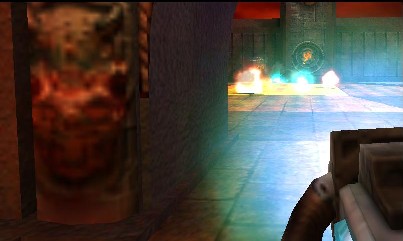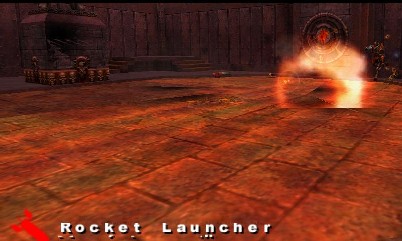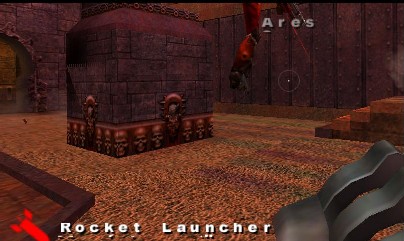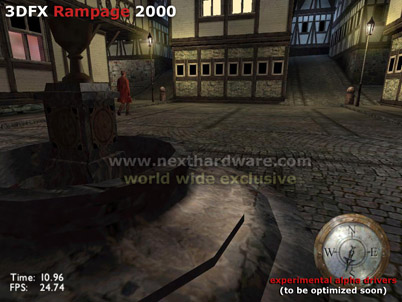
| Rampage Specification | Data |
| Clock Speed | 200-250mhz |
| Process | .18 µM |
| Transistors | 30 Million |
| Core Size | 10.6*10.6cm's |
| Die Size | 11.44*11.47cm's |
| Core Information | 18 clock domains 14 core blocks 8 pad rings |
| Pipelines | 4 |
| TMU / Pipeline | 1 |
| Triangle Rate | 20 - 30 MT/s |
| Fillrate | 800-1000 MP/s |
| RAMDAC | 350mhz |
| RAM per rampage | 16-128MB |
| Memory Bus | 128mhz |
| Memory Bandwidth | 12.8 GB/s |
| Built in AGP | 4x |
| Sage Specification | Data |
| Clock Speed | 200-250mhz |
| Process Information | Same as Rampage |
| Transistors | 25 Million |
| Hardware Lights | 25 | Vertex Shader | 1 |
| Built in AGP | 4x. Busmaster for Rampage. |
| 2D Features |
| Hardware accelerated DVD playback (motion compensation, planar to packed pixel conversion) |
| 160hz at 640x480. 1600x1200 at 100hz. |
| NPR (Photoshop effects). Better known as Toon Shading. |
| 3D Features |
| OpenGL, GLIDE, and Direct3D 8.0 (ps11) API support. |
| 52 bit internal precision (12 bit per RBGA component). 32 bit output. |
| 8 bit stencil buffer. |
| 24 bit floating point Z buffer. |
| 2048x2048 texture resolution. |
| DXT, FXT texture compression. |
| 3D texture support. |
| 1 pass bi/trilinear texture filtering. |
| Up to 128 tap anisotropic filtering. |
| 1 pass and 1 cycle multitexturing and bump mapping. |
| LOD mipmapping. |
| Alpha blending. |
| Programmable fog effects. |
| Sub-pixel and sub-texel correction. |
| Flat / gourard Shading. |
| T-Buffer. |
| M-Buffer (explained below). |
| Hardware supported HSR. Not completey done in hardware, but it eliminates a 30-50% overdraw with a 1% visual error. This technology was from Gigapixel. (Thanks Tag) |
| Non-Photorealistic Rendering (from 3dfx's Immersion 2000 release) This is an extention of the VTA. VTAi (i = 0..3) VTAi-1 * (1-Alpha) + VTAi * Alpha C0 = Alpha TCU: (A+B)*C + D A: Zero B: Texture (Paint#Brush) C: C0 (Alpha) D: Zero CCU: (A+B)*C + D A: Zero B: Previous VTA C: 1 - C0 (1 - Alpha) D: TCU out |
| FSAA Features |
| M-Buffer (ie. Multisample-Buffer that was used on R4, also had T-Buffer support) M-Buffer allowed for 4 samples per clock to be generated at NO pixel rate loss, unlike the 4X hit taken by VSA-100 and T-Buffer. The Downside is that MS takes the same texel coordinates and jitters them, thus there's no texture clean up. 3dfx implimented the advanced Anisotopic filtering to remedy this once and for all. |
| Normal rendering: 1 texture per pixel: 800Mpps / 800Mtps 2 textures per pixel: 400Mpps / 800Mtps 3 textures per pixel: 200Mpps / 800Mtps 4 textures per pixel: 200Mpps / 800Mtps 5-8 textures per pixel: 100Mpps / 800 Mps (two clocks required) |
| Multisample AA - 800M samples per second: 4 textures, Free MS AA 2 textures + Anisotropic, free MS AA. |
| 4 GSamples/s for 8x MSAA. There were 4 pipes that were either pixel pipes or 4X MSAA pipes. |
| Quad texturing= 4xRGMS/noAF small performance drop Dual texturing= 2xRGMS/4xAF small performance drop |
| Quad texturing. In 1 clock. 8 Layers in 2 clocks, 1 pass. It's hard to describe Rampage's texturing abilities due to the flexibility. Actually, when using Quad-texturing, Rampage could achieve 'free' RGMS Anti-Aliasing. |
| Windowed AA |
| Line/Edge AA |
| Market | Card Name | Rampage | Sage | RAM |
| Entry Level | Spectre 1000 | 1x 200-225mhz | None | 32MB DDR 200-225mhz |
| Mid Range | Spectre 2000 | 1x 200-225mhz | 1x | 64MB DDR 200-225mhz |
| High End | Spectre 3000 | 2x 225-250mhz | 1x | 128MB DDR 225-250mhz |
| What If? |
| The original Rampage chip was actually scheduled to be released before the Voodoo 2. Of course it was much different than the later Rampage chips, but they never had all the features complete. Instead they released the Voodoo 2 as a gap filler until Rampage was ready. Ballard wanted a 2D/3D card ASAP though, so Banshee ended up being released. By that time, they ahd to completely redesign rampage, so Voodoo 3 was released as another gap filler and later the Voodoo 4/5 to stay in the market until Rampage was ready. 3dfx claimed bankruptcy before it was ever ready, but by the time of thier demise, it was working(to an extent). The Rampage chip would have been released on the cards named "Spectre", to be released late 2000, early 2001 if everything was on time. Since it wasn't on time, tapeout was scheduled for March 2001. They didn't want to continue the Voodoo brand name on account of a totaly new architecture. The only Rampage technology nVidia has used thusfar is a decent chunk of the 2D engine in the NV25 and NV30. There is speculation that 3dfx's Fusion design was merged with nVidia's original NV30 design (hence the FP16/FP32 dual formats) for the final NV30, but there is no proof of this. One of Rampage's lead engineers (Emmett M. Kilgariff) was responsible for the NV40's pixel shading and texturing technology (including the L2 cache implementation). About 100 3dfx engineers were asked to work at nVidia, and out of the ones that took the job, more than 60% of them were working on the nForce project (their input would go to the nForce2+). |
| Pictures |
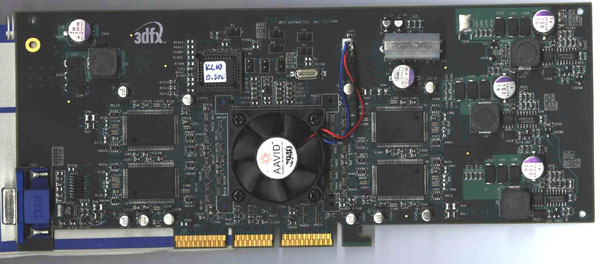 |
| Here is a picture of Rampage running on A1 silicon (from Amigamerlin at 3dfxzone.it). The only that exists today and it is still working (at least made by 3dfx ;)). |
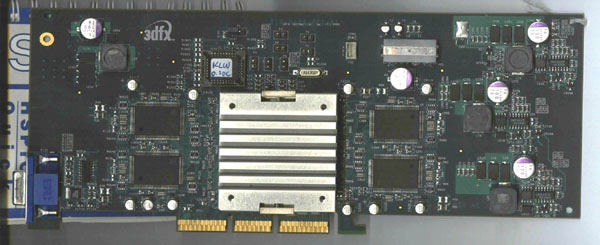 |
| Here is another picture of Rampage running on A1 silicon (from Amigamerlin at 3dfxzone.it). This board served as a test vehicle, before the chips get mounted down. That is a clam socket, you open it and put the chip in and close it. It makes a contact with the board without soldering. (-HankSemenec) |
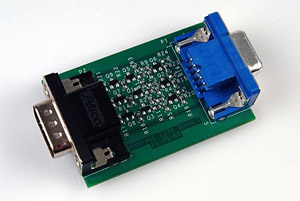 |
| Rampage needed this "Dongle" to flip the output of the VGA because Rampage's output was flipped. (above) |
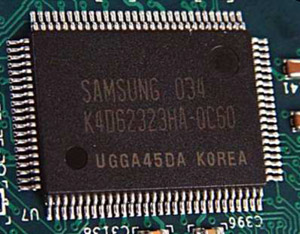 |
| The RAM on early Rampage revisions. (above) |
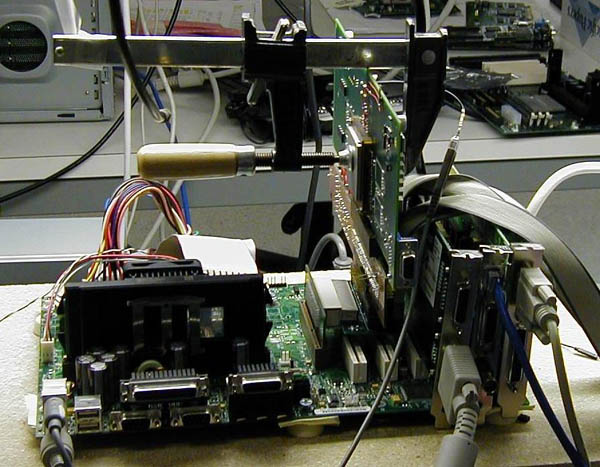 |
| That is infact an early Rampage running A0 silicon. The reason for the vice is that the socket on the original Rampage samples had an intermittent contact problem (electro-mechanical) and a 3dfx engineer thought the Vice-Grip idea up to save time while the A1 silicon was being used in the 2nd bringup board which was a proper fit (above). |
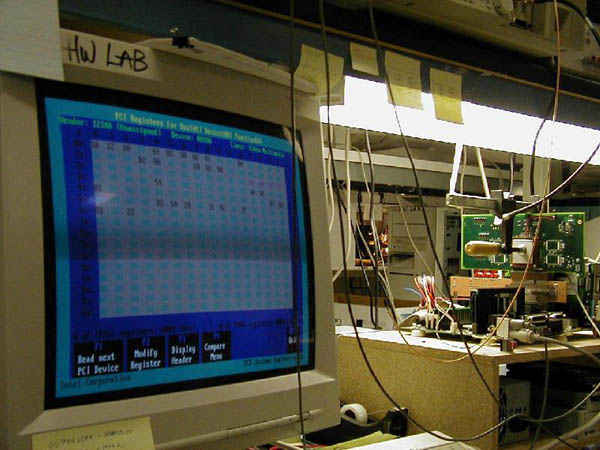 |
| The screen above is actually a BIOS editing program. One of the members from the x3dfx forums a while back(I'm sorry, I forgot who it was) actually decoded what the vendor information said in the BIOS. He found that it was actually the number for the Voodoo 3. Until it was confirmed that it was a Rampage, there was a rumor that it was the Voodoo 3. (above). |
| Rampage Files |
| Here is a Rampage Patent, now owned by nVidia (thanks Demirug). |
| Old Rampage Powerpoint Presentation (outdated specs 8/31/99) |
| Rampage Drivers |
©2002-2007 Rashly Productions - Home
